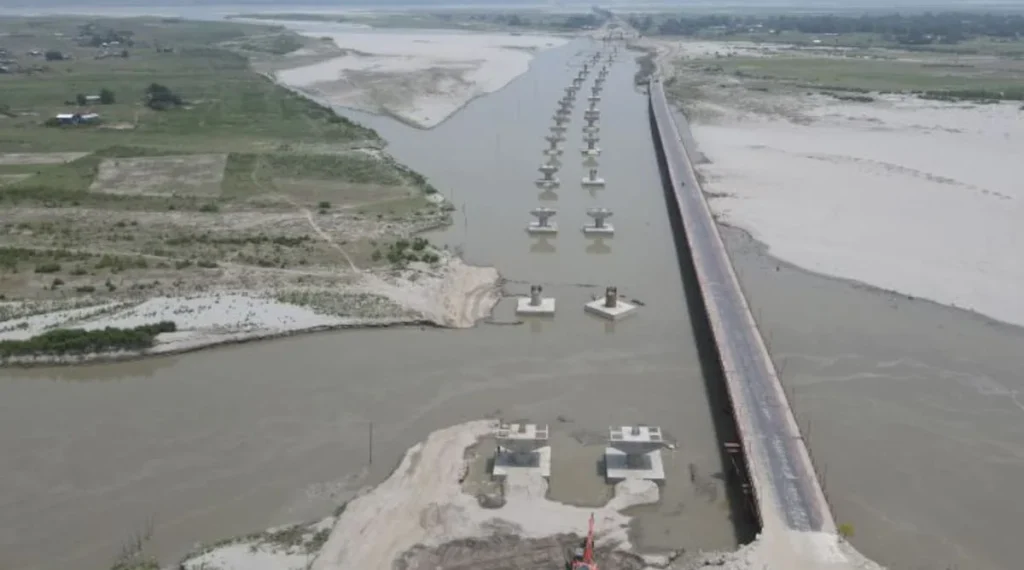India’s longest bridge, the Dhola-Sadiya bridge spanning the Brahmaputra River, stands as a symbol of progress and connectivity. Yet, its significance transcends mere engineering marvel, as it becomes a focal point for political discourse, shaping electoral narratives and aspirations of the people.
The Dhola-Sadiya bridge, inaugurated in 2017 by Prime Minister Narendra Modi, holds immense strategic and economic importance for the northeastern region of India. Connecting the remote regions of Assam and Arunachal Pradesh, the bridge slashes travel time and enhances accessibility, fostering economic development and integration of the region with the rest of the country. Its completion was celebrated as a landmark achievement, promising a new era of growth and prosperity for the people of Assam.
However, as Assam braces for elections, the Dhola-Sadiya bridge assumes a central role in political discourse, serving as both a catalyst for development and a battleground for competing ideologies. Political parties vie to claim credit for the project, leveraging its symbolism to bolster their electoral prospects. For the ruling party, it stands as a testament to their commitment to infrastructure development and the upliftment of the northeastern region.
Conversely, the opposition sees the bridge as an emblem of unfulfilled promises and misplaced priorities. They argue that while mega-projects like the Dhola-Sadiya bridge may grab headlines, they often overshadow the persistent socio-economic challenges faced by the people of Assam. Issues such as unemployment, agrarian distress, and erosion of cultural identity demand urgent attention, they contend, urging voters to look beyond grand gestures and scrutinize the government’s track record comprehensively.
Moreover, the Dhola-Sadiya bridge has implications beyond mere electoral rhetoric; it embodies the broader debate surrounding development and environmental conservation. Critics raise concerns about the ecological impact of large-scale infrastructure projects on fragile ecosystems, particularly in the ecologically sensitive Brahmaputra basin. The construction of the bridge has altered the river’s flow patterns, leading to concerns about erosion and disruption of aquatic life.
Furthermore, the bridge’s strategic significance in the context of border security adds another layer of complexity to the political discourse. Assam shares its boundary with neighboring countries, including China, and the bridge enhances connectivity to the strategic frontier areas of Arunachal Pradesh. Consequently, discussions surrounding national security and territorial integrity intertwine with electoral debates, shaping public perceptions and policy priorities.
Amidst these debates, the voices of the people who directly benefit from the bridge’s construction are often overlooked. For the residents of remote villages in Assam and Arunachal Pradesh, the bridge represents more than just a physical structure; it signifies newfound opportunities and access to essential services. Improved connectivity opens doors to education, healthcare, and markets, empowering communities and fostering socio-economic upliftment.
However, the realization of these benefits hinges not only on infrastructure development but also on inclusive policies and equitable distribution of resources. In this regard, the role of elected representatives becomes paramount, as they are entrusted with the responsibility of translating infrastructure into tangible improvements in the lives of the people.
As Assam heads to the polls, the Dhola-Sadiya bridge serves as a poignant reminder of the complexities inherent in the intersection of politics, development, and governance. It encapsulates the aspirations and challenges of a region striving for progress while grappling with myriad socio-economic and environmental concerns. Ultimately, the fate of the bridge and its legacy lie in the hands of the voters, who must navigate through the political rhetoric to make informed decisions that shape the future of Assam.


